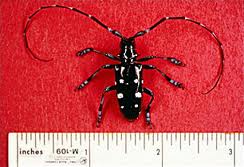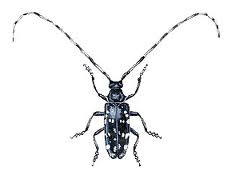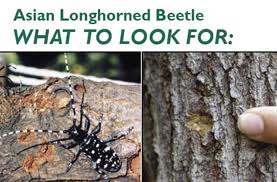This article is reproduced with the kind permission of Peter Walters MBE, Editor of ARBOUR; The Journal of Kent Men of the Trees. The item appears in the Summer 2012 edition.
Exotic Beetle Pest of Trees Found in Kent Issued jointly with Fera April 2012
n outbreak of the Asian Longhorn Beetle (ALB), an exotic pest which could have severe consequences for British trees, has been found in Kent, the Food & Environmental Research Agency (Fera) confirmed. This is the first time an outbreak of this pest has been found in the UK, and it is being treated extremely seriously. Fera and the Forestry Commission are taking urgent steps to eradicate the outbreak before it has the chance to spread further afield.
Several larvae of the beetle were found inside a poplar tree during a routine survey by the Forestry Commission at a site in the Paddock Wood area. Scientists from the Commission’s Forest Research Agency had been monitoring an area around the site where an adult beetle had been founding 2009, and this is the first sign of infestation. It is thought the beetles originated from wood packaging used to import stone from China at an adjacent industrial site. The beetle is not native to the UK and poses a serious threat to a wide range of broadleaved trees such as Maple (including sycamore), elm, horse chestnut, willow, poplar, birch and some fruit trees.
Speaking about action to eradicate the outbreak, Martin Ward, head of Plant Health Authority at Fera, said “Our plant health inspectors and the Forestry Commission are conducting a survey to determine the extent of this outbreak. They will be contacting all those within the survey area over the next few days and weeks with a view to inspecting all potential host trees for signs of the beetle. In the meantime we would urge members of the public, local businesses and landowners to be alert for the beetle and let us know if they see anything.”
Mature beetles emerge from trees beginning in late May and lasting through October with a frequency peaking in July. Tree infestation can be detected by looking for exit holes 15 to 20mm in diameter often in the larger branches of the crowns of infested trees. Sometimes sap can be seen oozing from the exit holes with coarse sawdust or "frass" in evidence on the ground or lower branches. Dead and dying tree limbs or branches and yellowing leaves when there has been no drought also signal ALB infestation. Research indicates this beetle can survive and reproduce in most sections of the country where suitable host trees exist.
Adult beetles are quite large – 20 to 40mm long and shiny black with variable white markings. Their antennae are particularly distinctive being up to twice the length of the body, black and bearing white or light blue bands. The larvae of the beetle feed undetected on the inside of the tree and can kill it or leave it weakened and susceptible to further insect and disease damage. Dr John Morgan, head of the Forestry Commission’s Plant Health Service, said, “It’s difficult to say exactly what measures need to be taken until we have completed the initial survey work to determine the extent of the outbreak. However, we will need to remove any trees found to be infested, and it is possible that we will need to remove potential host trees around the original site as a precautionary measure. Eradication measures to treat outbreaks in the US and Italy have resulted in the loss of tens of thousands of mature trees.”
Anyone who suspects they may have seen an Asian longhorn beetle, or evidence of its presence, should contact the Fera Plant Health Helpline on 0844 248 0071 or email planthealth.info@fera.gsi.gov.uk with details of where found. OS map references are helpful. If possible the beetle should be caught and put in a secure container so that an inspector can collect it. The beetles are not harmful to humans but should be handled with care as they are capable of giving a sharp nip. More detailed information about ALB can be found on the Forestry Commission’s website at www.forestry.gov.uk/asianlonghornbeetle.
Charlton Clark. Reproduced by Chris Stockwell. |
|
This article is reproduced with the kind permission of Peter Walters MBE, Editor of ARBOUR; The Journal of Kent Men of the Trees. The item appears in the Summer 2012 edition.
Exotic Beetle Pest of Trees Found in Kent Issued jointly with Fera April 2012
n outbreak of the Asian Longhorn Beetle (ALB), an exotic pest which could have severe consequences for British trees, has been found in Kent, the Food & Environmental Research Agency (Fera) confirmed. This is the first time an outbreak of this pest has been found in the UK, and it is being treated extremely seriously. Fera and the Forestry Commission are taking urgent steps to eradicate the outbreak before it has the chance to spread further afield.
Several larvae of the beetle were found inside a poplar tree during a routine survey by the Forestry Commission at a site in the Paddock Wood area. Scientists from the Commission’s Forest Research Agency had been monitoring an area around the site where an adult beetle had been founding 2009, and this is the first sign of infestation. It is thought the beetles originated from wood packaging used to import stone from China at an adjacent industrial site. The beetle is not native to the UK and poses a serious threat to a wide range of broadleaved trees such as Maple (including sycamore), elm, horse chestnut, willow, poplar, birch and some fruit trees.
Speaking about action to eradicate the outbreak, Martin Ward, head of Plant Health Authority at Fera, said “Our plant health inspectors and the Forestry Commission are conducting a survey to determine the extent of this outbreak. They will be contacting all those within the survey area over the next few days and weeks with a view to inspecting all potential host trees for signs of the beetle. In the meantime we would urge members of the public, local businesses and landowners to be alert for the beetle and let us know if they see anything.”
Mature beetles emerge from trees beginning in late May and lasting through October with a frequency peaking in July. Tree infestation can be detected by looking for exit holes 15 to 20mm in diameter often in the larger branches of the crowns of infested trees. Sometimes sap can be seen oozing from the exit holes with coarse sawdust or "frass" in evidence on the ground or lower branches. Dead and dying tree limbs or branches and yellowing leaves when there has been no drought also signal ALB infestation. Research indicates this beetle can survive and reproduce in most sections of the country where suitable host trees exist.
Adult beetles are quite large – 20 to 40mm long and shiny black with variable white markings. Their antennae are particularly distinctive being up to twice the length of the body, black and bearing white or light blue bands. The larvae of the beetle feed undetected on the inside of the tree and can kill it or leave it weakened and susceptible to further insect and disease damage. Dr John Morgan, head of the Forestry Commission’s Plant Health Service, said, “It’s difficult to say exactly what measures need to be taken until we have completed the initial survey work to determine the extent of the outbreak. However, we will need to remove any trees found to be infested, and it is possible that we will need to remove potential host trees around the original site as a precautionary measure. Eradication measures to treat outbreaks in the US and Italy have resulted in the loss of tens of thousands of mature trees.”
Anyone who suspects they may have seen an Asian longhorn beetle, or evidence of its presence, should contact the Fera Plant Health Helpline on 0844 248 0071 or email planthealth.info@fera.gsi.gov.uk with details of where found. OS map references are helpful. If possible the beetle should be caught and put in a secure container so that an inspector can collect it. The beetles are not harmful to humans but should be handled with care as they are capable of giving a sharp nip. More detailed information about ALB can be found on the Forestry Commission’s website at www.forestry.gov.uk/asianlonghornbeetle.
Charlton Clark. Reproduced by Chris Stockwell. |
|










Make A Comment
Comments (0)